#Exposed Rock
Explore tagged Tumblr posts
Text

Underground office workspace in Bahnhof Pionen data centre, Stockholm, Sweden
#bahnhof pionen#data center#stockholm#sweden#interior#underground bunker#exposed rock#office aesthetic#officecore#plantwave#plants#aes
55 notes
·
View notes
Text

https://www.instagram.com/cottonwoodandco
47 notes
·
View notes
Text

05/19/24 - Lago Vista, TX - LAKESIDE - Was out bike riding today and the normally closed gate to a gated community was open so I thought I would ride on in to see how the other half lives. The answer: same as us, they just have freaking better views. Oh well, at least I got to see this view of Lake Travis on a beautiful day. Although the lake is only half full, the water color with the exposed rock as a backdrop still looks really cool.
1 note
·
View note
Text
fellas. fellas. listen. qui-gon does express affection towards obi-wan, he just does it in the divorced dad way.
that's his love language, despite never having been married, divorced or had a kid.
#having to be reminded the child need to be fed clothed and watered cause he survives off just tea? yeah. divorced dad behaviour.#no idea how to say i love you so just hands the child random trinkets (rocks)#forgetting how old the kid is and accidentally exposing them to or taking them along on adventures that they're definitely too young for#i do think obi wan mentions he likes one food when he's 13 and that's all qui gon feeds him forever#trust me i am the leading source on this my father has been divorced THREE TIMES#qui gon jinn#qui gon and obi wan#obi wan kenobi#star wars
824 notes
·
View notes
Text

@joemomrgneissguy SPACE MINING. HO BOY.
So when mining comes into a conversation, there are several 'laws' of mining and processing that I like to consider that people tend to forget:
Location and rarity of commodity
Location and rarity of extraction techniques/reagents
What is necessary for this operation to work?
Where does the finished product go?
Some of these are extraneous. Theoretically, we don't have to care that iron is common on earth and might be present on the moon, so it changes the conversation from "why?" to "how would we?". Same with extraction and reagents. If you don't care how expensive it is to ship- for example: water and carbon dioxide to the moon because you want to process He-3, nothing can stop you.
However, what will stop planning, is processing. Blowing up a rock is easy. Collecting the rock and breaking it into a usable form is not. If there isn't a plan for exactly what commodity is being mined and how to separate it and all the equipment that needs to be made to get it into a usable form, and a plan to get that equipment into space. God help the poor bastard.
And fundamentally, no matter HOW you turn it, people use the finished product. If there are no people where you are mining the Thing, you need to have a way for the Thing to get back to the people who need it. WHY are you mining the Thing? What is economic about the Thing being made? and Is it worth the money?
[angry geologist rant under the cut]
So the thing about space and asteroids is metals come in native form a lot of the time because there's nothing to oxidize them; it makes processing simpler and the density increases profit. This is usually what people talk about when they go off about space mining: Ohh, if we just reach this asteroid 400 years away there's so much Gold and Platinum! Ohh, if we just crashed a FUCKING ASTEROID INTO EARTH OR MARS we could be so rich!
However this is a LIE for two reasons: It's actually harder to process straight sulfides or straight metal because they aren't brittle. Instead of breaking into smaller pieces you can separate and process, they jam the crusher. Universities with mining departments often have huge chunks of impressive high-grade sitting around that were donated by companies when they jammed their fucking system. If you can't break it down, it's a useless fucking clump of rock.
Secondly, even if you have native metals clumped together like an iron-nickel asteroid, unless you want an iron-nickel product, you have to separate them. Since it's not brittle, you would have to pour a bunch of hydrochloric on it and wait for the reaction to dissolve the outer surface.
And all this is assuming the metals are on Earth. If not, you have to figure out how to do this in space. How much HCl will you need? How are you going to fly it up there? How are you going to break it down? How are you going to replace parts when they inevitably break?
The big "commodity" on the moon is Helium-3, which is extremely rare on Earth. (So yes, we have a need, and yes, there's substantial reason to mine it in a place where it's more accessible.) The logic starts breaking down around "getting it back" and "how does the operation work": In moon quantities (up to 15 parts per billion (ppb)), you have to mine about 150 tons to extract 1g of He-3. That's not unreasonable, to be honest, since economic gold hovers around 7-12 ppb. And technically you'd only have to heat the rock to 600-700 C. However, things do melt at those temperatures. Then you have to get it back to earth. Either a SpaceX-style return and come back, or a drop shipments- It's just insane to me though that we would use SO MANY RESOURCES to rip up the fucking moon, even with an automated system, when if you look at He-3 we already produce what equals 11 pounds of He-3 yearly from Oil and Gas deposits, it's just not collected.
I have more beef with planets that are theoretically resource-rich, but people just- don't care about getting them back to Earth? Venus has significant metal-Sulfides and Tellurides in its atmosphere, which is why people joke about the "floating oxygen colonies" on Venus. But congratulations! You've colonized a planet that is inaccessible to human technology because anything we've ever designed will dissolve. Same with Europa. To design something that works on Venus - not to mention extracts things in the proper form to be used in human conditions - and/or get them back to Earth means redesigning how we think of the properties of the periodic table.
With extraction, we play a lot with oxidation states, and one of the rules is to stay within Earth's aqueous conditions. If you oxidize anything too much, your solution will want to vaporize to oxygen. Reduce anything too much, and your solution will want to vaporize to hydrogen gas.
So, if you design anything on Earth designed for conditions on Venus, it will be unstable. If you design anything on Venus meant for Earth, it will be unstable.
Which is kind of the end of my rant, I guess. Don't crash something into Earth unless you can process it. If you can process it in space, can you get it back? Who's responsible when the thing breaks? Why the fuck is money being spent when 9 times out of 10 we have it here on earth with the conditions we're familiar with?
If we've somehow depleted Earth enough that we need resources from other planets, which would insinuate we have not figured out how to recycle our own metals, which is untrue, and likewise we have no business in space anyway- Where did all our resources go? Are we leaving for those other planets? Do we have faster-than-light travel to collect the new resources in a timely manner?
There isn't even water in space half the time and if you do have a colony on Mars and tech bros are going to process all the hematite to build their shitty underground Martian city, are they shipping water from the north and south poles to do this? Have they figured out how to renew the carbon filters that are going to be needed to get all the waste and organics out of it once it's used?
In my opinion, it's all just fucking stupid. Space mining tries to answer a question that doesn't need to be asked with people who don't know how mineral processing works who haven't thought what the logistics require and don't care that entropy demands even minerals in stasis don't last forever. But it's ~new~ and the dollar signs on metallic asteroids gleam in their eyes and I want to take out Elon Musk's kneecaps.
#Apparently a team in Europe proposed a way to separate Fe2O3 while producing oxygen. Which is definitely a step forward.#But I still say the actual water and reagents used to process rock to element are non-circular enough that it's a huge hindrance.#Anyway! Space mining! Quickest way to expose a techbro dipshit is ask where they'll get the water for iron oxide separation.#Fix our own planet and close the circuits in hydrometallurgy and then we can talk about space mining.#mining#geology#mineral processing#I hope this was actually legible and coherent lol. I didn't spend as much time on it as I did on the Gold one.#I hate space mining and gold mining for the greed and colonialist mindset.
132 notes
·
View notes
Text

#bnwosissy#barbie#bnwo propaganda#feminine sissy#blm#cute#makeup#transgender#transgirl#femboii#trans woman#team black#blond girl#blackmail me#sissy blackmail#black and white#cute blond#obedient#onlyfanz#exposed faggot#exposed and outed#black metal#metal#heavy metal#rock#pussy free#hypnosis#sissy hypnotize#blondie#blog
76 notes
·
View notes
Note
If it's okay can I request a yandere sir crocodile x single mother reader. I've been thinking about what would happen if the reader had a baby, like would they take the reader and leave the baby or take the reader and the baby. If they did take the baby what would happen, would they be mean to the baby, nice to the baby, or just distance. Would they become a platonic yandere. I'm so sorry if I already sent this in, I can't remember if I did or not.
Yeah I got the first one, but dw about it lol tumblr can get weird with asks anyway.
Rambling under the cut! Not sure if you meant literal baby, child is of ambiguous age but can talk.
Hoo boy you've handed me a rough one, huh? I don't think Croc is a kids guy. But I don't think he'd be outright horrible to a small, unthreatening child- if not because of standards, but because it just isn't worth his time or energy to direct actual hatred toward. Yes, he was willing to destroy a whole country and hundreds of lives which no doubt included children, but I think that degree of faceless separation is very different from looking at a kid directly and going "Yeah I'm gonna kill this. Personally. With my hands." Vivi was 16 and Luffy was 17 iirc but one is an important opposing political figure with crucial information on his misdeeds, and Luffy... is Luffy. Idk. What I'm saying is at the very least I don't see him being abusive or disposing of the child- he does like you, and that's a pretty surefire way to destroy you and any reason you have to cooperate.
It could be a "cooperate and your child remains happy/unharmed" situation but tbh I don't wanna write that. Child abuse is a topic I'm willing to touch on in specific circumstances, mostly backstory but I don't really want to write about canon characters doing it. So I simply won't lol. Reader inserts can be held against their will and mistreated but I don't want to involve a kid in that dynamic, so if I write something where the reader is caring for a kid (such as Galley on 4th) then the yandere in question does things through much softer more under-handed methods.
Honestly? The best way I see this working out is Pre-Alabasta arc where Crocodile is still seen as a hero by the masses. There's a good chance that, at least initially, his affections start and end with you. Is irritated if he finds out about the kid after he's decided that he likes you. But you- you're a little slice of domesticity, you fit into his life rather nicely, he thinks. Plus you and the brat help round out his image as a wholesome do-gooder, don't you? A protector of the people, and a loving husband and father to boot. The... dark parts of his business all swept under the rug and kept away from you both, of course.
His dates with you are no doubt extravagant, but he prefers your kid not accompany the two of you on these. Probably prefers to shower them in expensive gifts, rather than spend much one-on-one time with them. I think he could get attached but he'd be in denial about it for a bit. He's able to rationalize the lack of time spent with them to you, specifically in public- he's a notable figure, is he not? While he's a Warlord and could no doubt protect the both of you(his pride will NOT have you believe otherwise), he just doesn't want the risk. You're an adult with full comprehension of the possibility of being targeted, so it's different. He is a good actor, though. While he doesn't spend as much time with the kid, he's good enough that they don't feel actively disliked. A bit... put out, maybe. It's possible your kid just... thinks he's really cool, despite it. Mysterious, close yet distant, someone who makes mom happy and is the reason they both have all this nice stuff, now. Which can be annoying, but stroking the ego doesn't hurt the kid's case. Liking the bananawanis would score them a couple points too...
-
"Do you think I could, um, meet them sometime? Y'know, if you aren't busy..." Crocodile raises a brow, taking in the brat sitting in a chaise lounge chair. They're leaning forward, looking hopeful- swinging their little legs in anticipation. They look comically small compared to the chair. He chuckles, takes a drag of his cigar- turning his head away from the child to exhale. "...I'm not sure if I can do that without consulting your mother first," he muses, watching the kid visibly deflate. Even if he knows the bananawanis will listen to him, that they would pose no threat if he did not wish them to do so- he preferred you to be happy. Introducing your small child to the large, imposing reptiles used as guard-dogs behind your back would be unwise. "So I'm afraid you'll only be looking from a distance or through glass, unless we can get her approval. We could always ask though, hmm?" The kid grins at him- and Sir Crocodile feels a disquieting lack of disdain.
#one piece x reader#yandere one piece#... pretty light on the yandere tbh#basically he begins only treating the kid well to ensure your affections but starts liking them#for angst maybe he does finally start connecting with em only for the strawhats to finally rock up and expose everything with Vivi :')
50 notes
·
View notes
Text
"no see they're not being transmisogynistic, they don't hate trans women! they're specifcially talking about *men*, and trans women aren't men! so no one would EVER refer to them as such"
wow you're sooo smart, you're so smart and understanding, your brain is huge y'know that. you're sooooo intelligent and thoughtful and you really get it y'know, you smart person you.
#juney.txt#this post brought to you by me hearing someone say ''baeddel actually refers to effeminate men. which trans women are not''#like have you been living under a rock never exposed to mainstream transphobia for the entirety of your life or something#transmisogyny
215 notes
·
View notes
Note
do i.. WANT to know about the drumlins?
YES YOU DO
Drumlins are glacial landforms, which means you find them only in places that have been glaciated. And they're very distinct when you know what you're looking for.
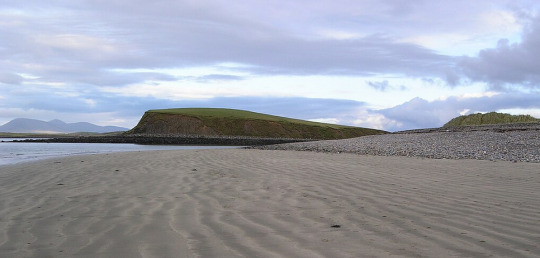
A hill with one steep side, one looooong sloping side, and you've (most likely) got yourself a drumlin. (Unless it's small. Drumlins are tens of meters high and hundreds of meters long, so if you've got a short one with way more elongation, you've got a drumlinoid.) They're all over Canada,the north eastern US, and northern Europe. The one pictured above is in Ireland. The ones in Canada and the US formed as the Laurentide Ice Sheet, a kilometers thick mass of glacial ice, was spreading across North America during the Last Glacial Maximum
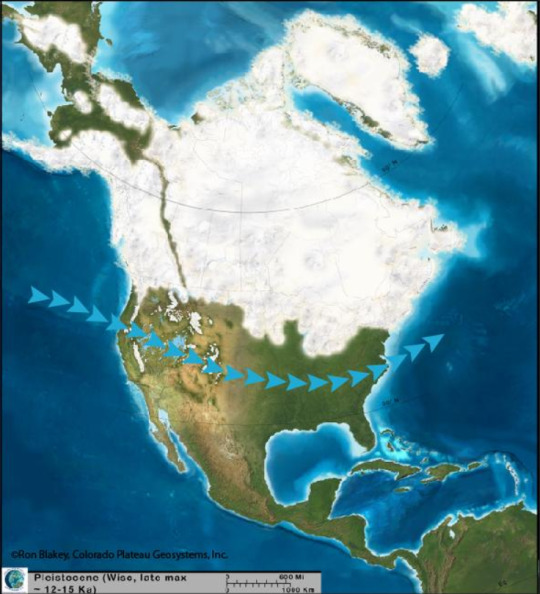
There are lots of really cool glacial landforms (eskers and kames and lakes (Glacial Lake Agassiz my beloved) and like a dozen types of moraine), but drumlins are my favourite because they're so incredibly easy to identify, they occur in swarms, and they're kinda weird as hell
There's still some debate among geomorphologists about how, exactly, they form but I was told that the (mindbogglingly huge mass of) ice catches on a sticky uppy bit of bedrock and instead of mowing it down like a child kicking over a stack of blocks, moves around it instead. And because there's now a place behind the bedrock where there's less ice, the ice drops a whole bunch of glacial till (all the bits of sediment that did get mowed down like a child kicking over a stack of blocks) on the other side of the bedrock bit

(This is a constructional theory, where the drumlin is built up. the other main one is the erosional theory, where everything but the drumlin is eroded. There's also a theory that drumlins are deposited by subglacial meltwater, but that one is highly controversial)
"Now wait," I hear you say, "go back a bit. What the fuck was that about swarms?"
They occur in swarms.

If you've got one drumlin, good chances you've got a lot of drumlins. Which is actually amazing, because the steep side of the drumlin faces the direction of flow, which means we know exactly how the ice sheet moved. In this image, for example, the ice started at the top, near Lake Ontario, and then moved south. From looking at drumlins (and other glacial landforms, we do like to have multiple reference points), we know that the Laurentide Ice Sheet started in the Hudson Bay and crept out from there
And because they're so distinct (tear drop shaped, made of till, occur in swarms), and because drumlins can only have been made by glacial activity, we can look all over the world and find these things and know that this place was once under several thousand tonnes of ice

Not during the Last Glacial Maximum, but definitely ones before it. And I just think that's neat
#'glacial till' I say as if all till isn't glacial#that's only in there for the non-geologists tbh#I love drumlins so much#they're neat#rocks#long post#Loxie has words#geology#geomorphology#These thing can be made of some weird things too#Here in Alberta we're on carbonate rock#because of that ocean that used to be here before BC crashed into us#but we've got granite in our till deposits#which was imported here by the glacier express from Ontario#where the Canadian Shield is exposed#the Shield which is made of granite and other igneous rocks#(we've got granite too but it's buried *deep* beneath the carbonate)
243 notes
·
View notes
Text
Whenever Will is slouching or staring off into space, Mike will walk up to him, do his best Bowie voice and say "babe, you're looking sad today" while caressing his cheek before kissing him just because he knows he's so bad at doing Bowie's voice and it always makes Will laugh
#mike cheering will up by doing bowie impressions and failing because mike is no richie tozier but will still finds it amusing#imagine bowie saying babe you're looking sad today while caressing your face...ahhhhh bowie#will is a bowie stan and gets mike into bowie a bit but mike mostly likes more metal rather than rock#because he thinks that rock especially glam rock is too gay and it will expose him so he just chills with the music eddie introduced him to#stranger things#byler#mike wheeler#will byers#david bowie#byler endgame#byler headcanon#byler hc
43 notes
·
View notes
Text

The more you see,

The more you want.

Especially if we’re talking about
Me. 
나, 멋지? 이사공칠공사
#junfit#서준#맹남#대흉근#에로남#korean eros#bulletproof pecs#한국남#power men#asian superheroes#korean muscle worship#male cleavage#korean pecs#canyon cleavage#korean dynamite#rock hard muscle#male perfection#asian muscle worship#massive pecs#massive masculinity#open shirt#armor abs#six pac abs#exposed abs
40 notes
·
View notes
Text


x x
#u#web finds#cds#physical media#music#diva destruction#goth#gothic#exposing the sickness#passion's price#gothic rock#90s#2000s#00s
142 notes
·
View notes
Text

https://www.pinterest.com.
406 notes
·
View notes
Text

When I scrolled by a retweet of another Q&A translation mentioning an underwear question I'll admit this was not what I thought the post it was potentially talking about would be like
#like. i don't have that much respect for kubo and talking about the underwear of characters is kinda weird#but also that answer kinda rocks? kdnfjfkgngkf#bleach#bleach canon#bleach lore#ig??#was there a difference in the way i used these two tags i can't remember#shinji#op#kinda#do i dare tag the character o.O;#i mean i tagged bleach so#hirako shinji#shinji hirako#i. oh dear. i'm exposing myself to strangers#o///o#underwear post everyone! rejoice! :')
15 notes
·
View notes
Text
Gansey and Ronan having opposite music tastes and then Adam’s the perfect neutral because he has no music tastes he just likes that they like what they like
#s speaks#s rereads bllb#trc reread notes#trc#rodansey#richard gansey#ronan lynch#adam parrish#I think Blue mostly likes avant garde music but does also like some of the more conventional rock Gansey likes#despite not wanting too. Also I think she was exposed to quite a bit of folk music growing up but of a very different sort than Ronan was#is Celtic folk music a thing will look up later
20 notes
·
View notes
Text


Amazon Drought Exposes Ancient Rock Carvings
Human faces sculpted into stone up to 2,000 years ago have appeared on a rocky outcropping along the Amazon River since water levels dropped to record lows in the region’s worst drought in more than a century.
Some rock carvings had been sighted before but now there is a greater variety that will help researchers establish their origins, archaeologist Jaime de Santana Oliveira said on Monday.

One area shows smooth grooves in the rock thought to be where Indigenous inhabitants once sharpened their arrows and spears long before Europeans arrived.
“The engravings are prehistoric, or precolonial. We cannot date them exactly, but based on evidence of human occupation of the area, we believe they are about 1,000 to 2,000 years old,” Oliveira said in an interview.

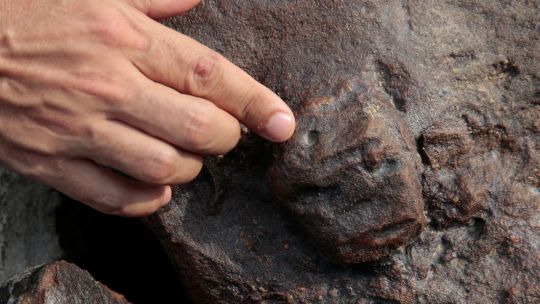
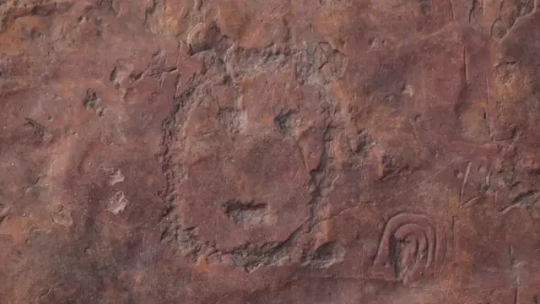
The rocky point is called Ponto das Lajes on the north shore of the Amazon near where the Rio Negro and Solimões rivers join.
Oliveira said the carvings were first seen there in 2010, but this year’s drought has been more severe, with the Rio Negro dropping 15 meters (49.2 feet) since July, exposing vast expanses of rocks and sand where there had been no beaches.
“This time we found not just more carvings but the sculpture of a human face cut into the rock,” said Oliveira, who works for the National Historic and Artistic Heritage Institute (IPHAN) that oversees the preservation of historic sites.
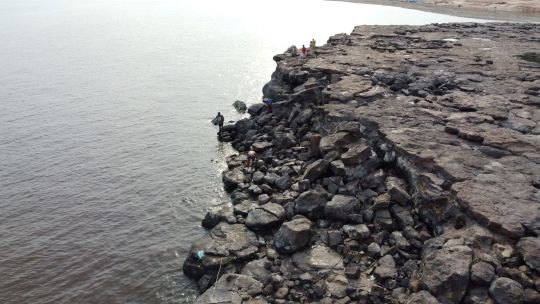
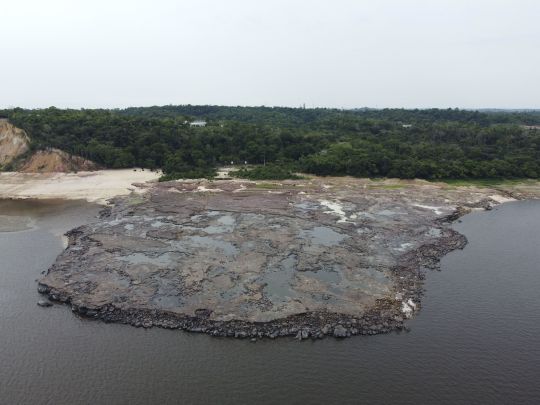
#Amazon Drought Exposes Ancient Rock Carvings#amazon river#Ponto das Lajes#rock carvings#ancient carviings#ancient artifacts#archeology#archeolgst#history#history news#ancient history#ancient culture#ancient civilizations
102 notes
·
View notes